No products in the cart.
Drones
Ultimate battle: DJI Mavic Pro vs Phantom 4, which is best for you?
There comes a moment in every man’s or woman’s life when it is time to get into a serious relationship. The same applies when one wants to buy a high-end drone. As things stand at the moment in the drone business there are only two relevant options for a long-lasting relationship with your drone – a DJI Mavic Pro or a Phantom 4. But if you think that this means the decision will be easy, you couldn’t be further from the truth.
We are here to discuss the big question, which one is better, the DJI Mavic Pro vs the Phantom 4.
NOTE: Before we get into the details, we have to point out what actual models we are comparing. The original Phantom 4 is no longer produced, and as of 2017, if you want to buy a new Phantom, it will be either a Phantom 4 Advanced of a Phantom 4 Pro. Those two variants are the ones we are referring when we say The Phantom 4.
Table of Contents
- DJI Mavic Pro vs Phantom 4 Overview
- Design and Durability
- Battery life and power
- DJI Mavic Pro vs Phantom 4 Price
- Mavic Pro vs Phantom 4 Accessory Prices
- Phantom 4 vs DJI Mavic Pro Camera
- Field of view
- Focus and depth of field
- Shooting in low light
- Flying the DJI Mavic vs Phantom 4
- Flying in the wind
- The drone controllers
- Using the DJI Goggles to fly the Mavic / Phantom 4
- The verdict
DJI Mavic Pro vs Phantom 4 Overview: Size and Portability
We’ve already reviewed the DJI Mavic Pro separately, so you might want to start by reading our Mavic Pro Review here while the Phantom 4 has featured on our list of drones to buy which integrate with iPhones/iPads. So we’re quite the big fans of both of these drones.
There is a significant distinction when it comes to size of these two drones. You can maybe think that it doesn’t really matter what the size of a drone is because it is always in the air, but as everyone who has experience in this field can tell you, that is not the case. As you are traveling and searching for the best locations for your shooting, you want the equipment to be as light and compact as possible.
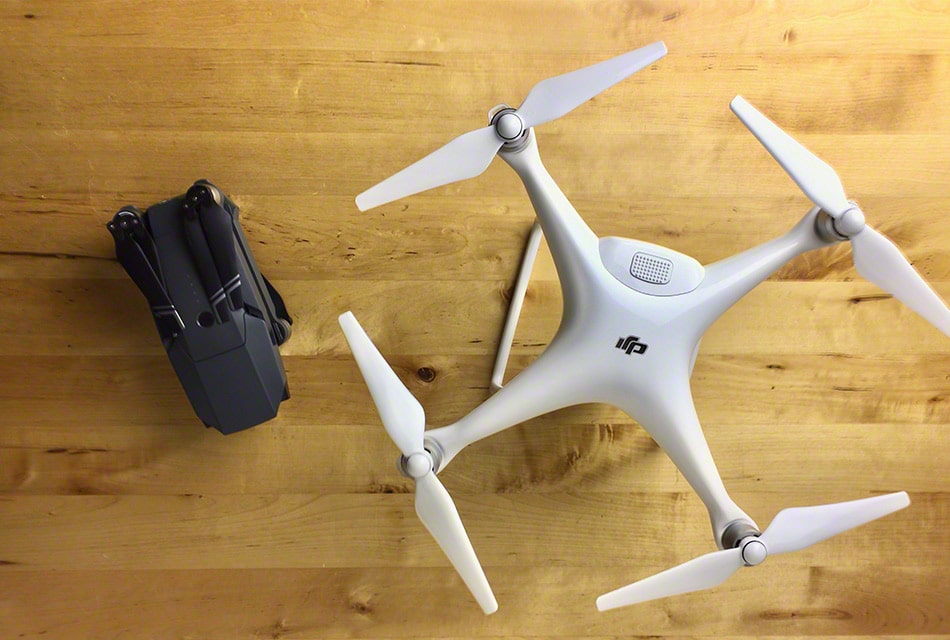
And this is where the Mavic SHINES.
The Phantom 4 is an old-school tough guy who weighs twice as much as the new kid on the block. It must be said that is was the original DJI Phantom Pro which kick-started the revolution of prosumer drones. The Mavic Pro is much smaller, more compact and can actually fold into a tiny package so you can pack it in any regular backpack or a case and carry it around.
The Mavic Pro is much smaller, more compact and can actually fold into a tiny package so you can pack it in any regular backpack or a case and carry it around. The only DJI drones which is smaller would be the DJI Spark, but this does not actually fold. If you’re wondering about the DJI Mavic Pro vs the DJI Spark, you might want to read our showdown. Size and foldabiltiy is particularly important when you plan to perform extensive travel with your drone. Most hobbyists are looking to get drone footage on their travels. The Mavic easily takes the throne here – it is the portability king.
This is not the case with the Phantom. It cannot fold, and is significantly heavier. You will need to buy a custom case to be able to transport it safely. And, when we say custom case, you should see dollar signs flying through the window. But, it’s size does come in handy in certain circumstances. It’s motors and propellers are larger than the ones on the Mavic, so you can easily use it to lift packages or other objects and transport them. This can become very useful in outdoor activities and long distance shootings.
It cannot fold, and is built significantly heavier. You will need to buy a custom case to be able to transport it safely. And, when we say custom case, you should see dollar signs flying through the window. But, it’s size does come in handy in certain circumstances. It’s motors and propellers are larger than the ones on the Mavic, so you can easily use it to lift packages or other objects and transport them. This can become very useful in outdoor activities and long distance shootings.
If you’d like to see what other people think about these two drones, this is TheVerge’s first look at the Mavic and here is TechRadar’s first look at the Phantom 4.
Design and Durability
The thing that will right away become apparent is the difference in size. And this is something that can be very important to a lot of drone buyers. In this regard, Mavic is more modern because it’s lighter, smaller and can fold. Its aggressive style is not only for
In this regard, Mavic is more modern because it’s lighter, smaller and can fold.Its aggressive style is not only for
Its aggressive style is not only for show also. It is carefully crafted to have as little air resistance as possible. The other difference you can instantly notice is the level of noise that these drones make. As you can imagine, the Phantom 4 is much louder, but that’s because it has bigger and stronger propellers – which need to work harder.
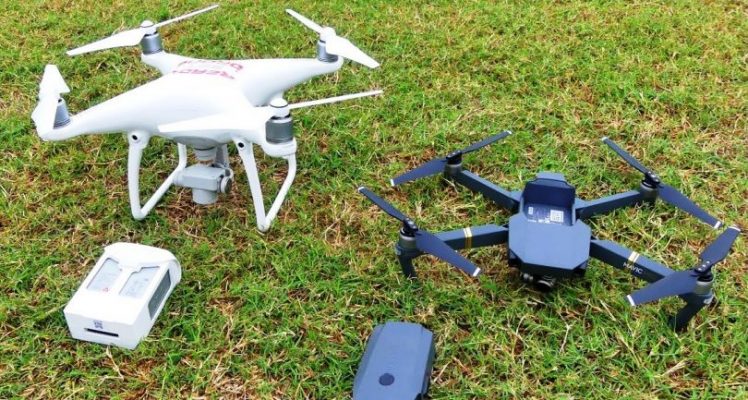
The most obvious thing, that sometimes people forget to think about is the color of the drone. Since, the Phantom 4, is bright white it stands out more during flight. It’s counterpart, the Mavic is gray which can sometimes be frustrating when trying to locate it. So far, it has become evident that the white color is the best for drones, so it is not clear why big companies still try to be creative on this field.
When it comes to durability, both drones are engineered and crafted very well and can uphold some serious damage inflicted upon them. The only advice for both models that we can give is that you should be very careful with rain, snow or any water because these guys don’t like it. However high end these machines might be, there is a completely different segment of waterproof drones and the two kinds should not be confused.
Battery life and power
Although the specifications say different, both of these drones actually have a flight time of around 28 minutes which is very good.
However, when it comes to speed, we can easily see the difference. When put in “sport” mode, the Phantom 4 can fly at the speed of 44mph, while the Mavic Pro can only do 40mph.
This can come as somewhat of a surprise since the Phantom is a little bigger than its counterpart which also makes it more stable under some conditions.
Of course, in reality the Phantom has significantly stronger motors and propellers. This is also evident when it comes to the top ascending speed which is 5 m/s for Mavic and 6 m/s for the Phantom. But, when the range is in question, the Mavic Pro has an upper hand with 4.7 miles in comparison to Phantom’s 3.1 miles.
DJI Mavic Pro vs Phantom 4 Price
When you are even considering one of these two models, you should be ready to invest some serious money, but let’s see which one is going to set you back the most.
Although the Phantom 4 is an older model, it’s undiminished reputation holds its price at $1,199.
On the other hand, you can actually buy the Mavic Pro for circa $750 but keep in mind that that’s without the controller. Which, you will obviously need if you want to get some decent flight out of the Mavic.
Still, the standard package with everything ready for flight is still $200 cheaper than the Phantom at $999. This difference in price tells more about the market than it does about the quality of the products.
The Phantom 4 actually cannot lower its price because it would mean that the company has made its legend obsolete. And nobody wants to admit to something like that.
Mavic Pro vs Phantom Accessory Prices
This pricing argument becomes more clear when you compare the prices of two extra batteries and other essential gear you’ll want to buy. Videogrpahy pros in particular will need to seriously consider this question.
If you want them for your Phantom 4, they will come at $338, but for the Mavic Pro, they are just $178. And it’s like that with all the other accessories.
If you want to charge all those batteries more effectively, you will need a charging hub. This thing will set you back $35 dollars more if you own a Phantom 4.
You might also need some ND filters (reduce the daytime light to the lens and smoothen out the motion in your videos). An ND filter for the Phantom will cost you $29, while a package of three for the Mavic costs $35.
All in all, just for the basic accessories you will save between $200 and $300 if you decide to buy the Mavic. Do the math. Expect to pay quite a bit more for the Phantom!
Phantom 4 vs DJI Mavic Pro Camera
When you have a look at the specifications of the two cameras, it will instantly become very obvious which one is better. This is going to be primary reason why we buy a drone most times, so the image quality, video qualtiy, and camera specifications are going to make a real difference.
It will all be clear to you when you closely examine the two setups. When designing the Mavic, the company has opted for a completely new gimbal that is much smaller than the previous one found on the Phantom 4.
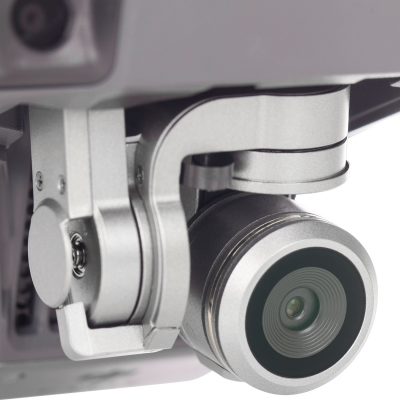
The different sizes of the cameras used is also evident. The one on the Phantom can be compared in size and shape to a GoPro, but the one on the Mavic resembles a small camera similar to ones you find on smartphones.
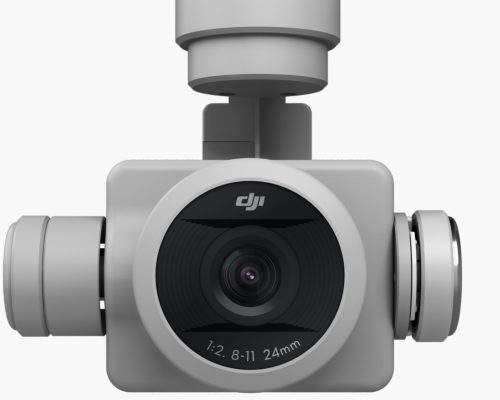
Don’t let this fool you, both cameras are very good. But not equally.
Concerning the video features, it all comes down to the small, but important details.
Both cameras can capture true 4K videos, the Mavic Pro with 4096×2160 at 24/25/30fps, and Phantom 4 Pro with the same resolution but at up to 50fps. And the numbers keep dipping in the favor of the latter.
The highest FHD video possible is 1920×1080 in both cameras, but with 120fps, the Phantom is better than the Mavic that tops out at 96fps. The compression codec is also better in the Phantoms camera by 40 mbps. When it comes to video recording, the biggest difference is certainly the ISO setting which is doubled in the Phantom 4 at 6400 comparing to 3200 found in Mavic Pro.
Photo features are also contrasting.
The shutter is electronic on the Mavic, but mechanical on the Phantom. The pictures that you take with Mavic can have a maximum capacity of 4000 x 3000 or 12 megapixels while the Phantom produces maximum image size of 5472 x 3648 or 20 megapixels. And, with highest photo ISO setting in Phantom larger by 11200, it is quite clear that the Phantom takes another victory in this heavyweight battle.
If you prefer to believe your own eyes rather than the numbers, take a glance at this comparative video test.
Many customers are wondering why DJI didn’t mount the same camera found on the Phantom to the new Mavic.
It will all be more clear when you consider the dimensions of the two drones.
With the Mavic (as opposed to the DJI Phantom), everything had to be reduced in size and weight.
That’s why the sensor size of its camera is only1/2.3” inches while the one on the Phantom is a full 1 inch. A compromise had to be made in order for the Mavic to become the most portable drone available on the market. And also, if the bulkier and better camera was fitted, it would significantly reduce the flight time which is something that cannot be compromised with high-end drones.
Field of view
When the Phantom first came to the scene, everybody was completely stoked about its cameras ability to record wide areas. The Phantom 4 Pro and Phantom 4 Advanced are somewhat narrower in that aspect, but they are still ahead of the Mavic. The best way to imagine the Mavic’s field of view is if you think of a 28mm lens attached
The Phantom 4 Pro and Phantom 4 Advanced are somewhat narrower in that aspect, but they are still ahead of the Mavic. The best way to imagine the Mavic’s field of view is if you think of a 28mm lens attached to a full frame camera. With that said, although the lens on the Phantom is 24mm, it is wider by 5.2 degrees which makes the difference. But, this difference doesn’t necessarily tip in favor of either of the competitors, it is really a matter of personal taste.
In this section, we can also mention an interesting fact about the propellers on the Mavic.
When you are flying the Mavic, during hovering you can point the camera up and the propellers are only fractionally seen. Also, during forward flight, the two drones act differently which affects the shooting process.
The camera on the Mavic has a tendency to lean downward thus never showing the propellers. This is not the case with the Phantom 4. Although this can seem as a minor issue, if you are a professional in this line of work these small differences can be the deciding factor when choosing you drone.
Focus and depth of field
Both of the cameras on these drones don’t have a fixed focus lens like the one we had the opportunity of using on the original Phantom 4. What this means is you have to tap the part of the image you want to focus on in the application.
This is the same old principle you are already using every day when shooting or taking photographs with your smartphone or tablet.
This feature can be helpful and is definitely a step up from the previous method, but it can also sometimes be a setback. With this adjustable focus you have the opportunity to bring about depth of field.
The closer objects can be in focus while the background is left blurry or you can do it the other way round and record the background clearly while the closer objects stay out of focus.
This is a very important feature especially when you are shooting in the outdoors, which is almost always the case with drone photography.
But, bear in mind, if you don’t do it and leave everything to chance, your images will be blurry. (We’ve even seen reviews who had originally this was a problem with the Mavic). With the manual focus lens, you have to be alert all the time to get the best of the surrounding landscape.
But the rewards will be very obvious and you will never be able to go back to the fixed focus lens.
Shooting in low light
It has to be said that for professional shooting, you need to be able to cover all aspects and light conditions. And that includes the evening or night shooting.
This is somewhat problematic with the Mavic Pro, especially when it comes to low light shooting. Every one of these cameras can shoot videos in low light, but the difference is there to be seen.
As you are probably aware, this is down to the fact that the Mavic has the max ISO of 3200, while the Phantom’s is 6400. The Phantom’s ability to shoot at a higher ISO rating means that the camera (and overall video quality) is again better than the Mavic’s.
If you want to see a long test of Phantom 4 vs Mavic Pro footage, the following YouTube video is great:
Flying the DJI Mavic vs Phantom 4: different features and flying modes
These two flying machines are equipped with the most sophisticated and intelligent features that will help you have a stress-free and (ideally) incident-free flight and a landing to match.
The obstacle avoidance feature is present in both of these – which is a really important feature, truth be told, especially if you are shooting in the distance. Some of the other capabilities of both drones are active tracking. This is essentially, sensors that are scanning the ground and / or terrain to follow the object which you are tracking with the drone.
DJI promises that all of these features are upgraded in the newer Mavic Pro, but they were already very effective in the Phantom, so it can be said that there is no real difference in this field.
However, the Mavic has some new features that Phantom doesn’t. For instance, there’s the ‘Tripod’ mode that allows you to slow it down to the speed of only 2.2 mph which gives you a more controllable flight for precision shooting.
This is very useful in tight spaces or indoors where you need all the help in maneuvering you can get.
And when you are done with this, you can turn on the ‘Sport’ mode which allows you to fly at top speeds with greater precision. This feature can be found on the both drones and works equally good, but it has to be said that with Mavic it is more fun because it is nimbler and more interesting to fly.
There are other modes, but we won’t turn this review into a full-on research of the flight modes of these two drones.
Flying in the wind
As an experienced drone pilot, when you think about windy conditions, your natural assumption would be that the heavier, larger drone would be more stable and behave better.
But, when it comes to these two, it doesn’t seem to be the case.
The Mavic is much smaller and lighter and still it seems to perform better under windy conditions. The Phantom sometimes has problems with stability and tends to drift in strong winds. This also says a lot about the design and the aerodynamics of the two aircrafts with the Mavic better equipped in this area.
But, when confronted with strong winds, sometimes it also comes down to the brute force or speed. When you want your aerial video to flow evenly, you don’t want to have too many changes in the speed of the drone’s flight. Those kinds of thing always show on videos of great quality. In this aspect, the Phantoms powerful motors are a plus. When faced with frontal winds, Phantom will more easily maintain its speed over the Mavic.
The Mavic / Phantom 4 controllers
As every drone enthusiast or a professional knows, the controller is as important as the little guy in the sky.
With these two drones, we have two totally different concepts.
To fly Phantom 4, you’ll be using the Lightbridge which has been around since the time of the DJI Inspire 1. It is reliable, familiar and easy to use. But, when DJI started the production of the Mavic Pro, they introduced the new communications system, the Ocusync. As the things stand, the only real advantage of the Lightbridge is the option of mounting a tablet, which is impossible on the Ocusync.
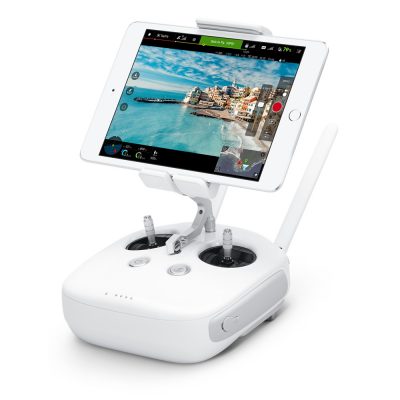
The Mavic Pro controller is much smaller and the mounting of your smartphone may take a while, but you will be well rewarded for it. It has an LCD screen for all the flight information, and you can charge it through the micro USB port.
And when it comes to the only real thing that matters, and that is lagging and control it is far more superior. Lightbridge will always have more latency and problems with connectivity, while the Ocusync will have none of those. And when it comes to flying and shooting top quality aerial videos, you want uninterrupted and smooth control all the time whilst seeing everything which is happening on your phone.
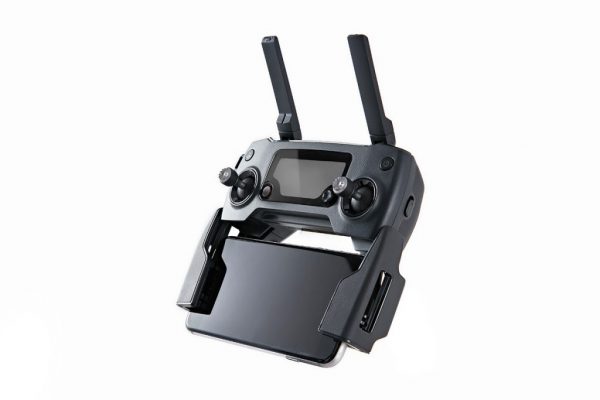
Using the DJI Goggles to fly the Mavic / Phantom 4
If you still didn’t check DJI Goggles, do some research, and you will be amazed. If you haven’t experienced the thrill of FPV flying, you’re missing quite a lot. With these Goggles, you bring the thrill of FPV flying to the Mavic or Phantom. Once you’ve bought a Mavic Pro or Phantom, this is the next big thing!
You can stream videos of up to 720p 60fps or 1080p 30fps in a whole new way. You can actually control the movement of the camera with head tracking, and of course you can also play games or watch movies with them.
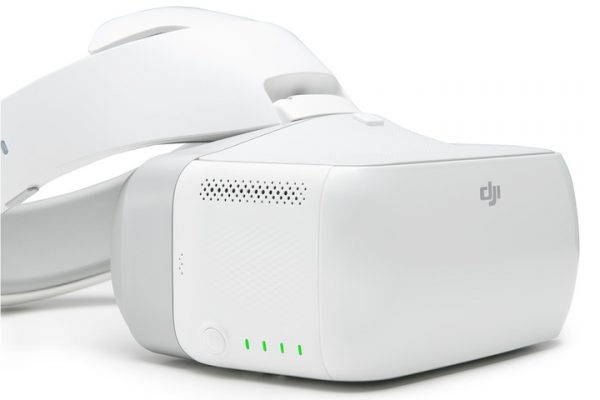
To the question in hand, the DJI Goggles will above all be useful to check what you are doing with your drone.
But the experience of flying your drone in first person panoramic view is something you really shouldn’t miss. And here’s the difference. With the Mavic Pro you can stream the video to the DJI Goggles wirelessly but with the Phantom 4, you will need two cables – a USB and an HDMI.
In this scenario, it is painfully clear that the old generation can’t really cope with the fast changes in technology. If you are into high tech stuff, and you probably are since you’re reading this, those two cables are just a nuisance you don’t need in your life.
The verdict
In the end, there can be only one winner, and we are confident that during this article you had the opportunity to see that we feel that the DJI Mavic Pro has a small edge on the Phantom 4, despite some better specs of the Phantom 4 vs the Mavic Pro.
It will offer mostly better specifications and features for a more reasonable price. It is true that some of the aspects of the Phantom are still better than the Mavic’s but all those numbers are very delicately balanced and the bottom line is that very few people will notice the difference.
As you noticed, almost all of its advantages are thanks to its camera. Yes, we know that there are a lot of hard core Phantom fans out there that will never admit the painful truth but, we have to state the obvious. The Phantom made a revolution in drones, and is still one of the best high-end products on the market which is a small miracle considering the number of competitors that have emerged in recent years.
However, times have changed and the technology has advanced, and the Mavic Pro is the way of the future. It almost has all the technical wonders of the Phantom, but is way cheaper, easier to use and you don’t need an armored suitcase to carry it around. When it comes to DJI Mavic Pro vs Phantom 4 – we chose the Mavic everytime.


What are your thoughts of these two drones? Have you flown or own both? Let us know your thoughts!